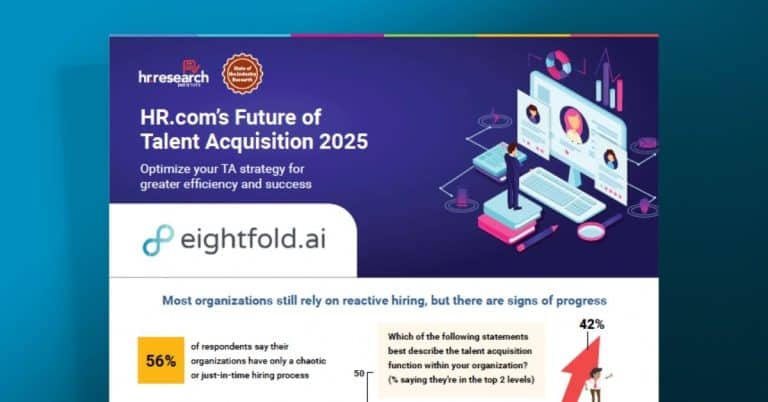
HR.com’s future of talent acquisition 2025
HR.com’s future of talent acquisition 2025
HR.com’s “Future of Talent Acquisition 2025” report reveals that while many organizations still rely on reactive, just-in-time hiring, there’s a clear shift toward more strategic, data-driven talent strategies.
Based on input from 200+ HR professionals, the infographic highlights top goals, persistent challenges, and the tools and technologies that define leading TA teams. Discover how today’s talent leaders are aligning hiring strategies with business outcomes and preparing for an AI-driven future.
3 key takeaways:
- TA maturity is rising: The number of organizations with “advanced” or “world-class” talent acquisition capabilities has more than doubled since 2021.
- Leaders use smarter metrics: TA leaders are over 2x more likely to measure candidate experience, quality of hire, and offer acceptance rates.
- AI and automation are critical: Tools like predictive analytics, chatbots, and CRM platforms are set to redefine how organizations attract and hire top talent.
Most organizations still rely on reactive hiring, but there are signs of progress.
- 56% of respondents say their organizations have only a chaotic or just-in-time hiring process
- 37% describe their TA function as advanced, meaning effective and strategically aligned
- But just 5% consider their TA approach truly world-class, being highly refined, proactive and directly contributing to business success
The good news, however, is the percentage of those that say their processes are advanced or world-class has more than doubled since 2021!
How might organizations improve their talent acquisition capabilities?
First, identify your goals and challenges
Among participants in our study, the most important TA-related goals are:
- 63% ensuring a robust pipeline of talent for future hiring needs
- 55% strengthening employer brand and employee value proposition
- 49% improving the candidate or applicant experience
The most common challenges are:
- 53% lack of candidates with required skills or experience
- 51% just-in-time, reactive hiring approach
- 42% compensation, total rewards are below market rate
Second, determine how to use tools and technologies to meet goals and overcome challenges
When compared to TA laggards**, TA leaders* are:
- over 13X more likely to have 5 or more paid TA tools and technologies currently integrated into their core TA tech stack
- over 3X more likely to use recruitment marketing platforms
- over 2X more likely to leverage the following as part of their hiring process: video or virtual interviewing software, employee referral software, CRM
Third, determine how you will quantify TA success
A majority of organizations use these tools to determine TA success:
- time to hire and/or fill
- employee retention and/or tenure
Compared to TA laggards, TA leaders are:
- over 2X more likely to measure: candidate experience, source of hire/hiring
- 2X more likely to measure quality of hire
- nearly 2X more likely to measure offer acceptance rate
Bottom line: While the common metrics are undoubtedly useful, consider other less common metrics to maximize impact.
Fourth, don’t forget to prepare for the future of TA
Our data shows…
The following technologies are most likely to be impactful to TA capabilities over the next 2 years:
- 44% talent intelligence/ predictive analytics
- 38% artificial intelligence/ machine learning
- 35% CRM platforms
AI is increasingly being leveraged in TA by:
- 58% writing job descriptions
- 53% using chatbots for engaging candidates
Organizations are most commonly expecting to automate these tools over the next 2 years:
- 48% interview scheduling
- 37% passive candidate sourcing or pipelining
- 35% onboarding
Given the research, consider these strategies:
- Identify your organization’s goals and challenges
- Assess your TA department’s level of capabilities
- Recognize areas where it needs improvements
- Select the right tools and technologies
- Align TA strategy with key business strategies
- Watch trends and anticipate possible futures
- Stay aware of how AI can be leveraged today and in the near future
You might also like...
Get the latest talent news in your inbox every month
By submitting this form, I consent to Eightfold processing my personal data in accordance with its Privacy Notice and agree to receive marketing emails from Eightfold about its products and events. I acknowledge that I can unsubscribe or update my preferences at any time.
